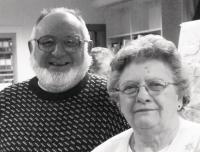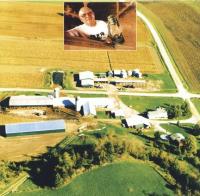Sharing Memories Of Elgin Springs Farm Celebrating Three Generations On The Land
By Cookie Steponaitis
| |
|
Vermonters are known for having a unique way of giving people directions to places. Farms are often used as anchor points since they have been a part of the landscape for generations. So, in keeping with that practice - if you go out the Plank Road, as the crow flies, just pass the second four corners and over the hill, you will come to Elgin Springs Farm, or as people around here call it, the Bessette Farm.
When Earl Bessette came to the Champlain Valley he was two years old and the year was 1932. His father and mother Solon and Helen Bessette moved to New Haven from Charlotte and rented land that to this day is still a part of the farm. The original farm was comprised of 286 acres and had 25 cows. Today, Elgin Springs Farm includes over eight hundred acres, and the third generation of Bessette’s milk 138 cows. For the past sixty years, Earl and his wife Raymonde have lived, worked and farmed the land that area people have come to think of as a cornerstone of New Haven and a long standing farm family.
"The name Elgin Springs farm came from a creamery that used to be across from the windmill on the property,” remembered Earl when asked about the name of the farm. “It was gone when my father came to the property and I remember filling in the cellar hole when I was a child. My neighbor Mark Peck recalls that he bought cream here.”
While history records the many changes in agricultural practice since the 1930’s hearing about them first hand from Earl and his wife puts a different lens on what being a farmer in Addison County means both then and now. “Everything was done by hand,” offered Earl as an opening comment. “We canned our food and had no electricity. We had an icebox with ice from the creek, but our backroom would have usually over 300 quarts of corn, potatoes, berries, and even meat. We butchered in the late fall and kept the meat in the backroom which was always cold anyways. You carried wood, fetched water and used an outhouse. We’d joke that running water was what you got when you run after it. We also use to have fun about the location of things on the farm. When you step out of the house onto the yard you are in Ferrisburgh, but in the kitchen, we ate our meals in New Haven.”
As early as 1934, Earl saw his father struggle with a huge setback when the cows contracted TB and he lost the whole herd. “Dad went to Wisconsin, I remember. He bought a new herd and they were Guernsey cows. There were many more colored cows in Vermont then than Holsteins. I had an urge to do agriculture and when dad was struggling so, I came into the farm and stayed. Farming is never without risks, but it is a way of life with many benefits.”
Sitting in Earl and Raymonde’s home on the farm brings any visitor a clear vision of what the family values. Adorning the walls are ribbons won for farm products at shows, walls of photographs documenting their seven children Earlene, Diane, Alan, Denise, Edward, Laurie and Lisa, as well as the fourteen grandchildren and six great-grandchildren. Next to the photographs are collections of models of each tractor ever purchased and used on the farm and cases of arrowheads found over the property by Earl. An avid outdoorsman and historian, Earl interweaves stories of the farm, hunting, trapping and changes to the Plank Road and New Haven community over time. He expressed worry that there are only six farms left today in New Haven that ship milk and looks to the future of agriculture in Vermont with a concern in his voice that makes anyone listening realize that times are not only hard for farmers, but headed into uncertain areas. “While our farm never really went high tech,” Earl remarked. “We milk with a pipeline and raise all of our own grain. We grind our corn and mix it with minerals and soybeans. The two large silos you see hold ground shelled corn. Over the years we bought parts of five other farms and still rent land. When my sons came into the business we got bigger just to survive. Now with milk prices so low, the farmer is caught from all sides. We have too much to pay out every month. The big farms are hurting just as much as the smaller farms.”
Visiting with Earl and Raymonde not only offer a window into the changes in farming since the early 1930’s but the land around as well. The Bessette farm has been featured in a film for children on Earl himself has written and recorded a book of memories of not only the farm but the town as well. A new edition of the original book, Wandering the Corners of the Elgin Springs Farm was published in 2009 and includes memories of his sister Eleanor (Bessette) Hawley and others. Included in its pages are also remembrances of farming, hunting, hurricanes, railroads, and changes in water, power and town systems, ice harvesting and much more. A poem written about Earl by neighbor and fellow historian Mac Parker captures the longevity, wit, and work ethic of the Vermont farmer who changes with the land, works the land, and holds both it and farming tradition with respect and reverence and is located in the back of the book.. So, if you find yourself out the Plank Road, as the crow flies, stop in Elgin Springs Farm. Earl and Raymonde will be there and they might even have a story or two to tell you.
Part of Eulogy for a Living Farmer (For Earl)
“You know this land the ways farmers do, its seasons, its hardships, its stories, you remember who lived in that fallen-down house and the men who worked in the quarries. You tell us about your school bus on an icy hill and the first time you saw your wife. You’re generous with your secrets you can only learn when you’ve lived here all of your life. You know where the rocks are hiding in fields, where the soil is sandy or clay. You know where the deer are feeding at dusk, you see them a mile way. You remember when milk was squeezed in a pail, then hauled away on a train. You remind us how farmers all worked together when it came time for thrashing the grain. You have a reverence for the old ways, but you’re not stuck in the past. Like the big old oak tree that guards your farm, you know we need deep roots to last…”


